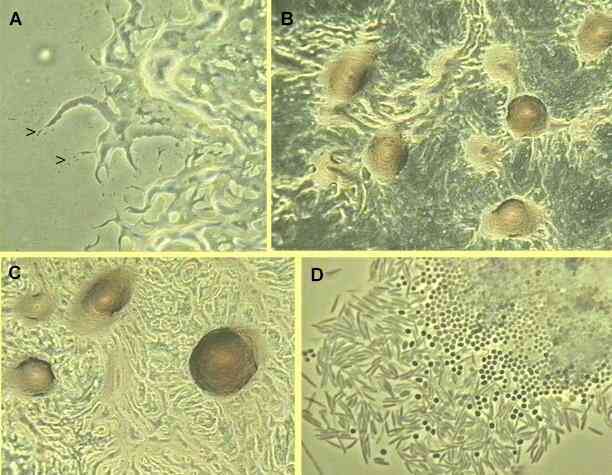Biology Dept Kenyon College |
More Microbial Development |

|
Biology Dept Kenyon College |
More Microbial Development |

|
| Microbial
development
Heterocyst formation in Anabaena and other cyanobacteria Cyanobacteria such as Anabaena grow as long filaments of photosynthetic vegetative cells. About every tenth cell, a vegetative cell differentiates into an anaerobic, nitrogen-fixing heterocyst. Heterocysts supply fixed nitrogen to neighboring vegetative cells in return for the products of photosynthesis. This separation of cellular functions is necessary because cyanobacteria have oxygen-evolving photosynthesis but the nitrogen-fixing enzyme, nitrogenase, is unstable in the presence of oxygen. The differentiation of heterocysts is provoked by an environmental cue, which is the absence of a fixed nitrogen source. The image below shows filaments of the cyanobacterium Anabaena. The arrow points to a heterocyst. Heterocysts are terminally differentiated cells that are highly specialized for nitrogen fixation. At least three programmed DNA rearrangements occur during heterocyst differentiation in Anabaena. The rearrangements involve the excision of DNA elements from the chromosome by site-specific recombination between short directly repeated sequences. Excision of two elements is shown below.
Genetic analysis of mutants that cannot differentiate properly has increased our understanding of the mechanism by which this differentiation occurs, as well as how the frequency of differentiating cells is regulated along each filament. One of the genes that has been shown to control heterocyst development is patS. Wild-type filaments (A) grown in complete medium and (B) in medium lacking nitrogen to induce heterocysts (arrowheads) are shown below. (C) Overexpression of the patS gene prevented heterocyst formation, and (D) deletion of the patS gene resulted in additional heterocysts with an abnormal pattern. Brackets indicate chains of contiguous heterocysts. Scale bars, 10 µm.
Fruiting body development in Myxococcus xanthus and other myxobacteria The myxobacteria
are an interesting
family of gliding bacteria that produce fruiting bodies in starvation
conditions.
Vegetative myxobacteria cells are elongated rods that glide across solid surfaces, secreting polysaccharide slime tracks in which cells migrate away from the colony edges (watch movie) When starvation conditions prevail and cell densities are above a threshold level, the cells migrate back along the slime tracks, aggregating by chemotaxis, to form large mounds of cells. These aggregates then develop into fruiting bodies (panels B and C, also closeup image) that are raised above the surface. As the vegetative cells migrate upwards into the fruiting body they undergo a progressive differentiation into spherical, thick-walled spores. A mixture of spherical spores and rod-shaped vegetative cells is shown in panel D.
 image from The Microbial World
Genetic
approaches are being
used to further our understanding of the mechanism of development in
myxobacteria.
A number of extracellular signals are necessary for fruiting body
development,
and mutants that have lost the ability to produce these extracellular
signals
have been isolated. These mutants are being used to dissect the genetic
program and to isolate and identify the signals.
|